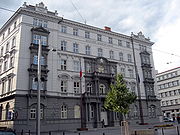
Supreme Administrative Court of the Czech Republic
Encyclopedia

Administrative court
Greece, as a civil law country has administrative courts. The establishment of those courts can be found in article 94 of the Constitution of the Hellenic Republic 1975, as revised in 2001. The administrative courts are composed from districts Courts of First Instance, district Courts of Appeal and...
s in Europe
Europe
Europe is, by convention, one of the world's seven continents. Comprising the westernmost peninsula of Eurasia, Europe is generally 'divided' from Asia to its east by the watershed divides of the Ural and Caucasus Mountains, the Ural River, the Caspian and Black Seas, and the waterways connecting...
it is considered a separate part of the judiciary
Judiciary
The judiciary is the system of courts that interprets and applies the law in the name of the state. The judiciary also provides a mechanism for the resolution of disputes...
.
History
The modern SAC can trace its origins back to BohemiaBohemia
Bohemia is a historical region in central Europe, occupying the western two-thirds of the traditional Czech Lands. It is located in the contemporary Czech Republic with its capital in Prague...
and Moravia
Moravia
Moravia is a historical region in Central Europe in the east of the Czech Republic, and one of the former Czech lands, together with Bohemia and Silesia. It takes its name from the Morava River which rises in the northwest of the region...
under the Austro-Hungarian Empire. From the mid-19th century until the formation of Czechoslovakia
Czechoslovakia
Czechoslovakia or Czecho-Slovakia was a sovereign state in Central Europe which existed from October 1918, when it declared its independence from the Austro-Hungarian Empire, until 1992...
, Czech rights with respect to administrative law were safeguarded by the Verwaltungsgerichtshof, or Austrian administrative court, which sat in Vienna. The Administrative Courts of the Czech Republic
Czech Republic
The Czech Republic is a landlocked country in Central Europe. The country is bordered by Poland to the northeast, Slovakia to the east, Austria to the south, and Germany to the west and northwest....
and Austria
Austria
Austria , officially the Republic of Austria , is a landlocked country of roughly 8.4 million people in Central Europe. It is bordered by the Czech Republic and Germany to the north, Slovakia and Hungary to the east, Slovenia and Italy to the south, and Switzerland and Liechtenstein to the...
thus have a common ancestor.
The Czechoslovak Republic
Czechoslovak Republic
Czechoslovak Republic was the official name of Czechoslovakia between 1918 and 1938 and between 1945 and 1960. See*First Czechoslovak Republic*Second Czechoslovak Republic...
set up its own administrative court which continued to function until the Czech coup of 1948, whereupon it lingered as a theoretical institution for a few years until it was wholly disbanded in 1952. In 1991, the Czechoslovak Federal Republic implied that it would set up a new administrative court in Article 36 of the Charter of Fundamental Rights and Basic Freedoms
Charter of Fundamental Rights and Basic Freedoms
The Charter of Fundamental Rights and Basic Freedoms is a document enacted in 1991 by the Czechoslovak Federal Republic, and continued as part of the great constitutional systems of both the Czech Republic and Slovak Republic...
, but failed to do so in its brief existence. The government of the Czech Republic
Czech Republic
The Czech Republic is a landlocked country in Central Europe. The country is bordered by Poland to the northeast, Slovakia to the east, Austria to the south, and Germany to the west and northwest....
not only renewed their commitment to this Charter in the constitution
Constitution of the Czech Republic
The current Constitution of the Czech Republic was adopted on December 16, 1992. It replaced the constitution of Czechoslovakia , which split into the Slovak Republic and the Czech Republic by act of parliament on January 1, 1993, through the so-called Velvet Divorce.The document is organized into...
, they also specified that the court of highest authority on administrative matters would be called the Supreme Administrative Court, as it had been in the Austro-Hungarian period. However, many of the specifics about the SAC were deferred to "later statute
Statute
A statute is a formal written enactment of a legislative authority that governs a state, city, or county. Typically, statutes command or prohibit something, or declare policy. The word is often used to distinguish law made by legislative bodies from case law, decided by courts, and regulations...
s". Parliament
Parliament of the Czech Republic
The Parliament of the Czech Republic is the legislative body of the Czech Republic, based in Prague. It consists of two chambers, both elected in direct elections:* the Lower House: Chamber of Deputies of the Parliament of the Czech Republic...
did not bring such legislation into force until 1 January 2003, when it passed law 150/2002, the Code of Administrative Justice. It is this document, more than perhaps any other, which actually returned a working administrative court to the regions of Bohemia, Moravia and Czech Silesia
Czech Silesia
Czech Silesia is an unofficial name of one of the three Czech lands and a section of the Silesian historical region. It is located in the north-east of the Czech Republic, predominantly in the Moravian-Silesian Region, with a section in the northern Olomouc Region...
.
Since 2003, the SAC has been characterized by a growing case load amidst understaffing and the search for a permanent location. The latter was finally accomplished in late 2006, when the court moved out of rented office space and into its new, permanent headquarters on Moravian Square in Brno
Brno
Brno by population and area is the second largest city in the Czech Republic, the largest Moravian city, and the historical capital city of the Margraviate of Moravia. Brno is the administrative centre of the South Moravian Region where it forms a separate district Brno-City District...
. Simultaneously, the Parliament has paid more legislative attention to the SAC, giving greater definition to the scope and powers of the court through several statutes.

